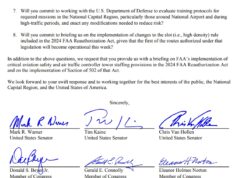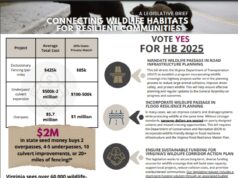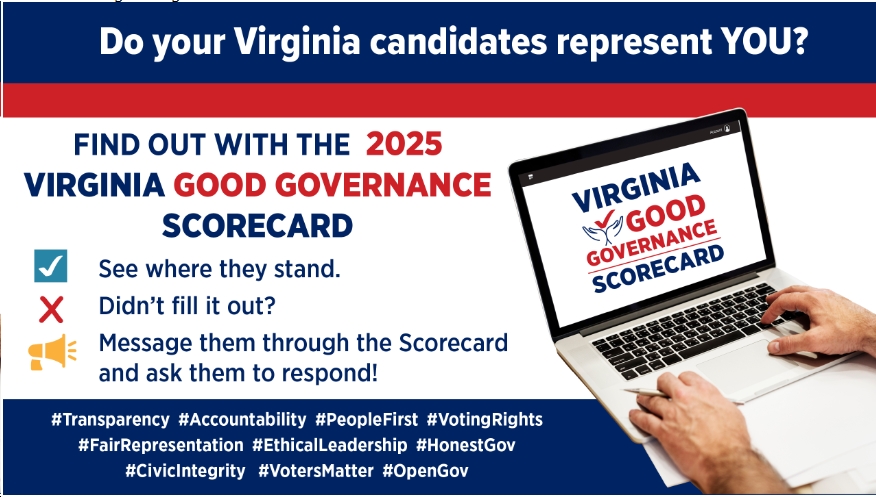From Sen. Mark Warner’s office:
WARNER, COLLEAGUES URGE ACTION ON SKYROCKETING MOTOR VEHICLE FATALITIES
~ Senators call on Department of Transportation to take action in a letter to Secretary Buttigieg ~
WASHINGTON – U.S. Sen. Mark R. Warner (D-VA) joined Sen. Ed Markey (D-MA) and his Senate colleagues in sending a letter to Department of Transportation (DOT) Secretary Pete Buttigieg highlighting the skyrocketing rates of motor vehicle fatalities and the need for swift action to reverse this trend.
The United States ranked first among 34 countries for the largest percentage increase in traffic fatalities in 2020. In the letter, the lawmakers note that nearly half of fatal crashes in 2021 can be linked to speeding, alcohol-impaired driving, or failure to use a seat belt. Additionally, the senators point out that dangerous roads also impact those outside the vehicle, with motorcyclists, pedestrians, and bicyclists accounting for 34 percent of all traffic fatalities in the past year.
“In May, the National Highway Traffic Safety Administration (NHTSA) reported that 42,915 people died in motor vehicle crashes in 2021, up 10.5 percent since 2020 and a shocking 32 percent since 2011,” wrote the senators. “Despite new technology and safety features, roads are becoming more dangerous for drivers, pedestrians, bicyclists, and other roadway users. We urge the Department of Transportation to continue to prioritize roadway safety and promptly employ new regulatory authorities Congress provided in the Infrastructure Investment and Jobs Act to reverse this disturbing trend.”
In addition to Sens. Warner and Markey, the letter was also signed by Sens. Richard Blumenthal (D-CT), Cory Booker (D-NJ), Sherrod Brown (D-OH), Dianne Feinstein (D-CA), Martin Heinrich (D-NM), Mazie Hirono (D-HI), Ben Ray Luján (D-NM), Alex Padilla (D-CA), Jack Reed (D-RI), Brian Schatz (D-HI), and Elizabeth Warren (D-MA).
The lawmakers requested Secretary Buttigieg respond to the letter, specifically to provide:
1. Clarification on the plan to implement the National Roadway Safety Strategy;
2. Explanation of the Department’s use of existing resources and authorities to meet or beat deadlines for issuing auto safety rules;
3. Explanation of lessons the Department has taken from other countries to reduce traffic fatalities.
Sen. Warner has been a national leader on transportation issues as one of the chief authors of the landmark bipartisan infrastructure legislation signed into law by President Biden last year.
A copy of the letter is available here and below.
Dear Secretary Buttigieg,
We write with grave concerns about the skyrocketing number of motor vehicle fatalities in the United States. In May, the National Highway Traffic Safety Administration (NHTSA) reported that 42,915 people died in motor vehicle crashes in 2021, up 10.5 percent since 2020 and a shocking 32 percent since 2011. Despite new technology and safety features, roads are becoming more dangerous for drivers, pedestrians, bicyclists, and other roadway users. We urge the Department of Transportation to continue to prioritize roadway safety and promptly employ new regulatory authorities Congress provided in the Infrastructure Investment and Jobs Act to reverse this disturbing trend.
Motor vehicle crashes remain one of the most common causes of death in the United States. Faced with an epidemic of traffic fatalities during the mid-twentieth century, Congress directed regulators to impose new safety requirements on automakers, including mandating that new cars include seatbelts and airbags, among other commonsense changes. Subsequently, motor vehicle fatalities declined, both in absolute figures and relative to total miles driven. Traffic fatalities dropped from more than 50,000 annually during the early 1970s to under 40,000 each year by 2008, and the fatality rate fell from 5 deaths per 100 million miles driven to 1.15 in 2009.
Unfortunately, during the 2010s, this decades-long progress in improving road safety came to a screeching halt and now has gone into reverse. As NHTSA’s data shows, absolute motor vehicle fatalities soared to nearly 43,000 in 2021, and the fatality rate hit 1.33. These trends are even worse for members of minority and low-income communities, who are disproportionately likely to be killed in a motor vehicle crash. Moreover, while traffic fatalities have risen in the United States, they have fallen in other countries. In fact, the United States ranked first among 34 countries for the largest percentage increase in traffic fatalities in 2020, compared with averages from 2017 to 2019. As you have rightfully declared, this is a national crisis.
This crisis has multiple causes. According to NHTSA’s recent report on traffic fatalities, in 2020, 45 percent of passenger vehicles in a fatal crash involved at least one of three behavioral factors: speeding, alcohol-impaired driving, and seat belt non-use. While the COVID-19 pandemic appears to have increased these reckless behaviors, our efforts to reduce them stalled even before COVID struck. For example, the absolute number of fatalities and fatality rate of alcohol-impaired driving stayed roughly flat over the past decade, before rising in 2020. Similarly, the percentage of front-seat passengers using seat belts rose steadily until 2016 — when it finally hit 90 percent — but has flat-lined since then. DOT data on speeding-related fatalities shows similar trends.
This stagnation in reducing risky behaviors masks important shifts in the affected populations. Individuals outside the vehicle — motorcyclists, pedestrians, and bicyclists, among others — now make up 34 percent of traffic fatalities, up from 20 percent in the mid-1990s.
This increase is particularly notable in urban locations, where traffic fatalities have risen by 48 percent over the past 10 years while they have declined by 6.2 percent in rural areas. Pedestrian fatalities are up a whopping 61 percent in urban areas during that period. The conclusion is clear: Roads remain extremely dangerous — for those inside and outside the vehicle.
The Department of Transportation took an important first step to address this problem by issuing its National Roadway Safety Strategy (NRSS) in January. In the NRSS, DOT, for the first time, set a goal of zero traffic fatalities or serious injuries and adopted a five-pronged “Safe System Approach.” This document is a laudable effort to recognize the traffic safety crisis and set achievable goals for implementing new safety regulations. Unfortunately, NHTSA’s record in issuing congressionally mandated rules — going back multiple administrations — raises concern that it may not meet the deadlines in the infrastructure law and the NRSS. While many of those deadlines remain over a year away, given last year’s fatality data, we urge DOT to move swiftly to implement these new rules ahead of schedule. There is no time to waste, and proven solutions — including congressionally mandated regulations requiring advanced driver assistance systems, advanced drunk and impaired driving prevention systems, and other safety improvements on new vehicles — are readily available.
Given the urgency of this problem, we ask that you please respond in writing to the following questions by June 29, 2022:
1. What steps has the Department of Transportation taken since January 2022 to implement the National Roadway Safety Strategy? What processes are in place to ensure all target completion dates are met?
2. How is the Department of Transportation utilizing existing resources and authorities to meet or even beat the deadlines for issuing auto safety rules as required under the Infrastructure Investment and Jobs Act? How can Congress further support these efforts?
3. What lessons has the Department taken from efforts by other countries to reduce traffic fatalities and accelerate safety improvements?
We applaud your tenacity in approaching this problem. As you declared on the first page of the NRSS, “We face a crisis on our roadways; it is both unacceptable and solvable.” We agree, and we stand ready to assist DOT and NHTSA as they undertake this critical mission to restart the regulatory engine that delivered such immense improvements in roadway safety during the latter half of the 20th century.
Thank you for your efforts on this important issue.

 Sign up for the Blue Virginia breaking news newsletter
Sign up for the Blue Virginia breaking news newsletter

![Rep. Don Beyer (D-VA08) on “reports of the devastating effects Donald Trump’s Project 2025 agenda would have on [Metro]”](https://bluevirginia.us/wp-content/uploads/2024/10/trumpmetro-238x178.jpg)







